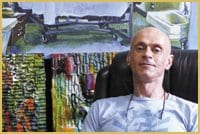Three times a week Tiko Kerr floats his 27-foot scull into the early morning or nighttime calm of Coal Harbour and casts off for a solitary rowing adventure to recharge his creative flow.
“Seeing the city from my angle is magical,” says Kerr, who has painted for 25 years.
The first thing I see as I walk into his Eastside studio is a colourful portrait of a fallen tree. This, Kerr tells me, is his barometer and the inspiration for his new show dedicated to “recreating Coal Harbour, as seen from the water.”
“I just felt so disoriented,” Kerr says, recalling the day he discovered his favourite tree had been blown over by the storm that devastated Stanley Park in December 2006.
As a rower, that tree was his marker. Kerr mourned its toppling. But the tree wasn’t dead. “It miraculously came back to life,” he states almost proudly.
This Stanley Park tree, which Kerr now calls his Lazarus Tree, is featured twice in his exhibit, once before the fall and once after.
It is no wonder that Kerr is so taken by the tree’s story. After all, its journey more than vaguely parallels his own.
Kerr, whose HIV-positive status had left him in “really bad shape” by 2005, banded together with a group of six other men who were in desperate need of better drugs if they were to regain their strength and survive at all. Together, they demanded access to experimental drugs not yet on the market. “It was the feeling that I didn’t matter,” he says of the uphill battle to get the medication he needed.
This show is, in part, a giving thanks to the supporters who’ve helped him through the past couple of years. The paintings are as overtly autobiographical as Kerr has ever been.
“They’re self-portraits,” he says, pulling forward one textured canvas after another from a pile leaning against the wall of his bright studio.
“They represent the past few years of struggle with medicine,” he explains. “I had boxes and boxes filled with all this medical paraphernalia.”
The canvases are first textured with syringes and bottles, prescriptions with his name on them; the images are then constructed atop these foundations. I’m not an art critic but I can’t help notice the overwhelming depth to Kerr’s colourful depictions of himself with drugs literally protruding from his face. His resilience is intertwined with the medications that saved him.
I didn’t really get this — I mean really get this — until Kerr pulled out a painting he did during his weak time when he did not have adequate medical help.
“This one I did at my most desperate,” he tells me as he lifts an ominous painting of an empty hospital room with a sterile made-up bed, and places it on an easel.
The austerity is spooky and I realize right in that second just how close Kerr came to dying.
I can’t take my eyes off the painting and feel frightened on Kerr’s behalf. Tears form in my eyes as Kerr tells me that the working title of the piece was My Government is Trying to Kill Me. I sob. Kerr laughs.
“I feel lucky. With all the misery that everyone experiences in their lives, artists or creative people have an opportunity to use it.”
He tells me how he would come into the studio in a rage sometimes, feeling — legitimately — that his government had given up on him, that he was expendable.
That painting (pictured on page 29) is not part of the show but the contrast helps me to understand what the show really means.
There is victory in the balance of Kerr’s new work. There is vibrancy, momentum and extraordinary self-awareness. Colours come alive, just as Kerr’s Stanley Park marker has also come back to life.
Kerr excitedly shows me another facet of his upcoming show. It is easy to see how he has poured his heart and life into the work he is about to share with the rest of us. Among the treats is something I have not seen before.
“Stop-frame animation is taking digital stills throughout the painting process and then screening them together,” he explains as we watch a video. It’s like watching the paintings create themselves. “It’s really fun,” he smiles.
In addition to offering gratitude to Vancouver for supporting him through his health struggles, Kerr’s exhibit is also an homage to his dear friend and mentor, painter Jack Shadbolt.
Kerr shows me a rusty red metal knife that belonged to Shadbolt. “A knife called defiance,” Kerr grins, holding it in his hand.
He holds it up to me, revealing the word defiance encrusted on the knife’s side. We both turn to look at the paintings of his face that line the room.
“When I finished that self-portrait,” Kerr says, again gesturing to my personal favourite, “I realized that that was my expression: Don’t screw with me. I’m here to stay.”

 Why you can trust Xtra
Why you can trust Xtra


